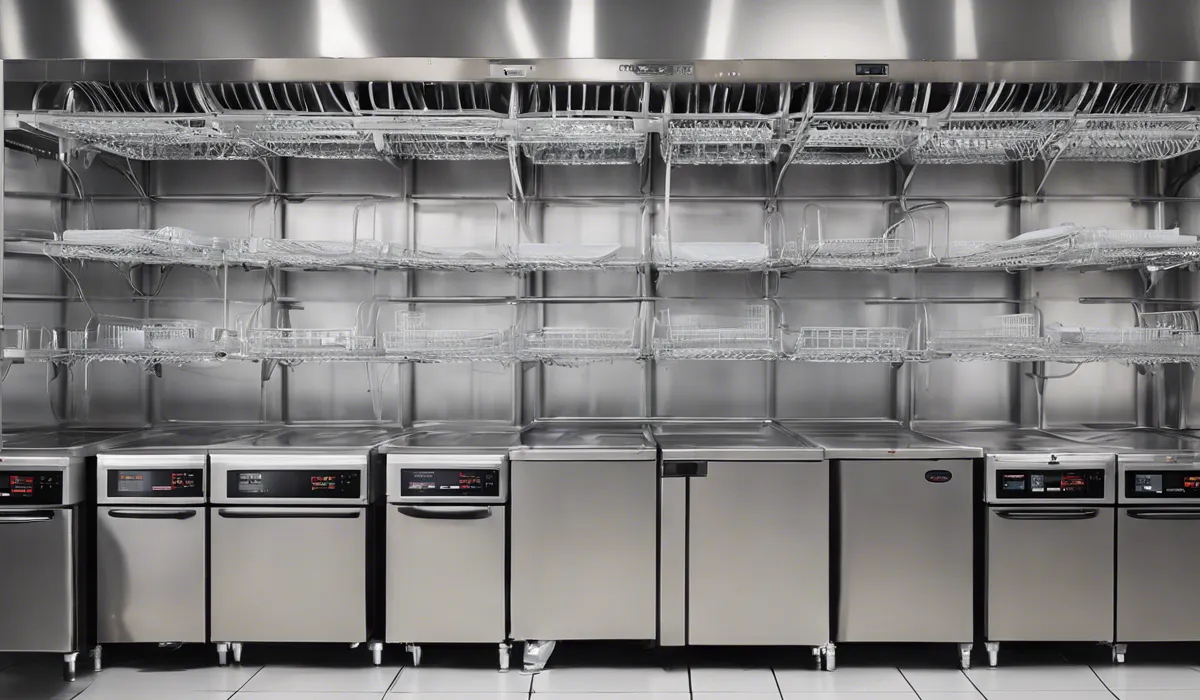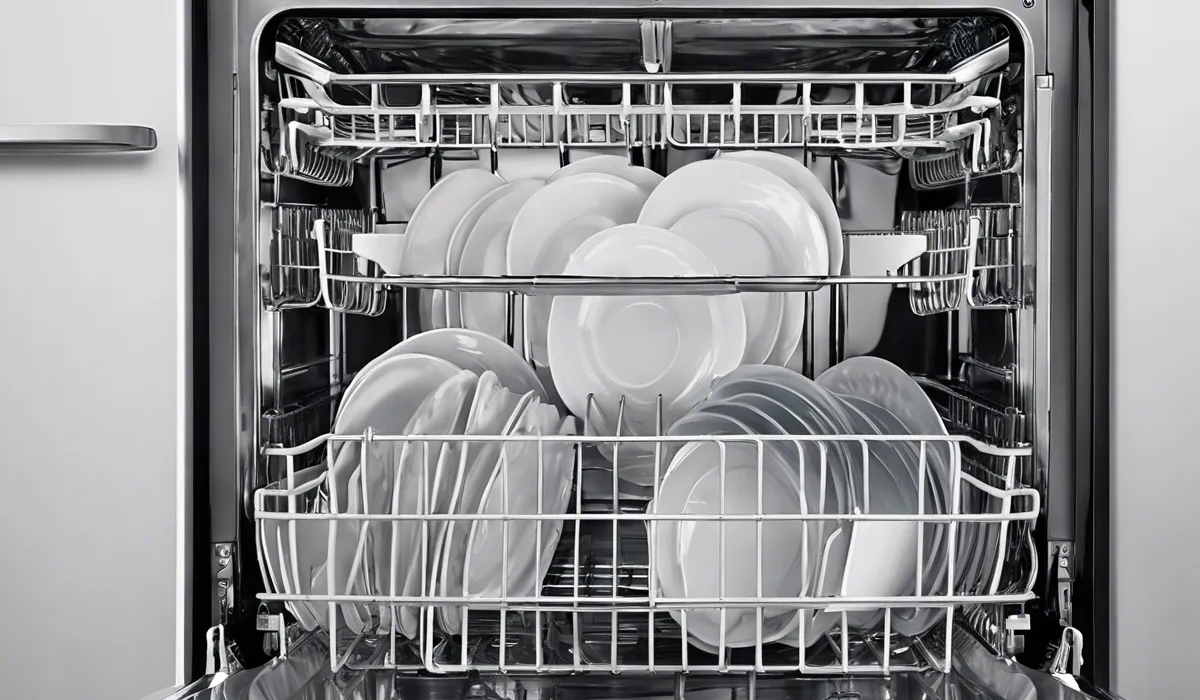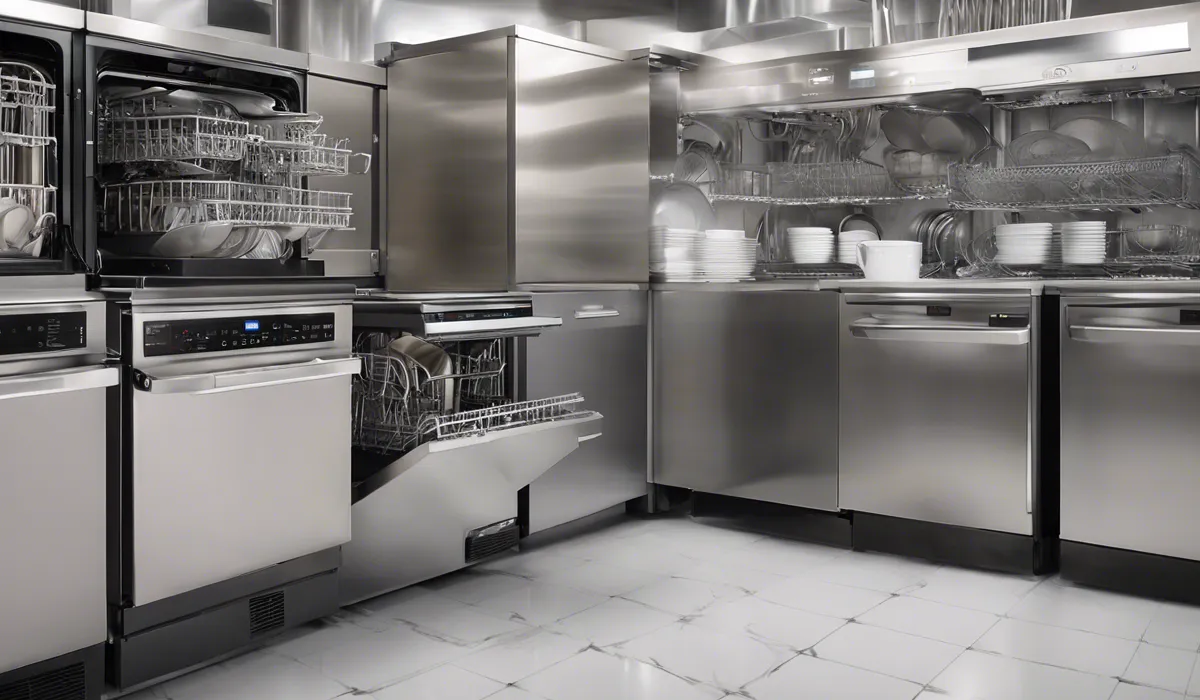What Temperature Should a Commercial Dishwasher Be?
A commercial dishwasher should operate at a minimum temperature of 160°F (71°C) for washing and 180°F (82°C) for sanitizing. These temperatures ensure proper cleaning and health safety by meeting regulatory standards.
Understanding Commercial Dishwasher Temperature Requirements

Importance of Temperature in Dishwashing for Hygiene
The temperature within a commercial dishwasher is crucial for ensuring dishes come out clean and hygienic.
High temperatures are necessary to remove food particles, grease, and to kill bacteria and other harmful microorganisms. This is not just about making dishes look clean; it’s about ensuring they are safe to use for the next customer.
Health Regulations and Standards for Commercial Dishwashers
Health regulations dictate the minimum temperatures for commercial dishwashers. To meet these standards, a dishwasher should operate at a minimum temperature of 160°F (71°C) for washing and 180°F (82°C) for sanitizing.
These temperatures are set to ensure that dishes are not only clean but also sanitized, reducing the risk of spreading illnesses.
Differences Between High-Temperature and Low-Temperature Commercial Dishwashers
There are two main types of commercial dishwashers: high-temperature and low-temperature models.
High-temperature dishwashers use hot water to clean and sanitize, while low-temperature models use chemical sanitizers to achieve the same result.
The choice between the two often depends on the setup and needs of a particular commercial kitchen.
Optimal Temperature Settings for Commercial Dishwashers

Recommended Temperatures for High-Temperature Dishwashers
For high-temperature dishwashers, the optimal washing temperature is at least 160°F (71°C).
The rinse cycle should reach a higher temperature, typically around 180°F (82°C), to effectively sanitize the dishes. These temperatures are essential for breaking down oils and ensuring the removal of bacteria.
Recommended Temperatures for Low-Temperature Dishwashers
Low-temperature dishwashers, on the other hand, operate at temperatures between 120°F and 140°F (49°C and 60°C).
Since the water is not hot enough to sanitize by itself, these dishwashers require the use of chemical sanitizers to ensure that the dishes are safe for use.
The Role of Sanitizers in Low-Temperature Dishwashers
Chemical sanitizers are vital in low-temperature dishwashers. They complement the lower temperatures to ensure that all harmful microorganisms are eliminated.
These chemicals are designed to be effective at these specific temperatures and must be used according to the manufacturer’s guidelines to ensure safety and efficacy.
How Rinse Temperature Affects the Drying Process
The rinse temperature not only plays a role in sanitization but also influences the drying process.
Higher rinse temperatures can lead to faster evaporation of water, reducing drying times and potentially improving the efficiency of the dishwasher’s cycle. This is especially important in busy commercial kitchens where time is of the essence.
Maintaining and Monitoring Dishwasher Temperatures

Regular Maintenance to Ensure Consistent Temperatures
Consistent temperatures are key to the effectiveness of a commercial dishwasher. Regular maintenance, such as inspecting heating elements and ensuring proper operation of the thermostat, can help maintain the correct temperatures.
This helps prevent the spread of germs and keeps dishware safe for customers.
Using Temperature Gauges and Thermometers for Accuracy
To verify that a commercial dishwasher is reaching the recommended temperatures, it is important to use temperature gauges and thermometers.
These tools provide accurate readings and can help identify any issues with temperature regulation before they become a health concern.
The Impact of Water Hardness and Incoming Water Temperature
Water hardness and the temperature of incoming water can affect a dishwasher’s performance. Hard water can lead to mineral buildup, which can interfere with temperature sensors and heating elements.
Adjusting the dishwasher’s settings or using water softeners may be necessary to counteract these effects.
Troubleshooting Common Temperature-Related Issues
When a dishwasher fails to reach the required temperatures, it is important to troubleshoot potential problems. This might include checking for clogged jets, malfunctioning heating elements, or insufficient water levels.
Addressing these issues promptly ensures the dishwasher continues to operate effectively and safely.
FAQs About Commercial Dishwasher Temperatures
What is the minimum operating temperature for a commercial dishwasher?
The minimum operating temperature for the washing cycle of a commercial dishwasher should be 160°F (71°C).
What temperature is required for sanitizing dishes in a commercial dishwasher?
For sanitizing dishes, a commercial dishwasher should reach a temperature of 180°F (82°C).
Why must a commercial dishwasher reach these specific temperatures?
These temperatures are required to ensure proper cleaning and to meet health safety standards by effectively killing bacteria and other pathogens.
Are these temperature standards the same for all commercial dishwashers?
Yes, these temperature standards are generally set by regulatory bodies and are consistent across commercial dishwashers to ensure health and safety compliance.
Can a commercial dishwasher operate effectively at temperatures lower than 160°F (71°C)?
No, operating at temperatures lower than 160°F (71°C) for washing may not effectively clean and sanitize dishes, which could pose health risks.
Final Thoughts
A commercial dishwasher must reach at least 160°F (71°C) for effective washing and 180°F (82°C) for sanitizing purposes.
Adhering to these temperature guidelines is crucial for ensuring thorough cleaning and compliance with health safety regulations.





